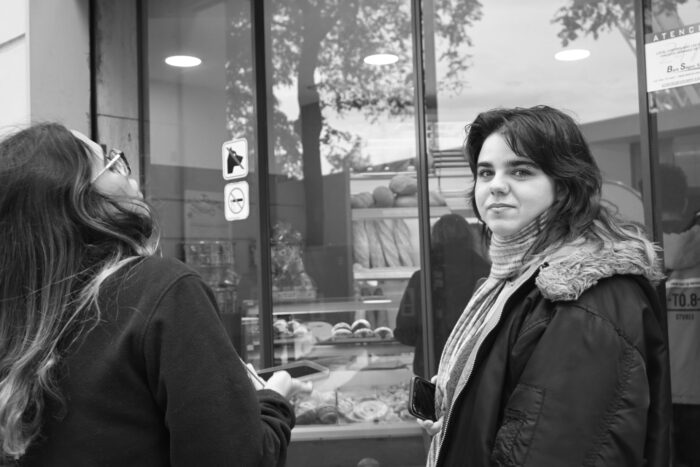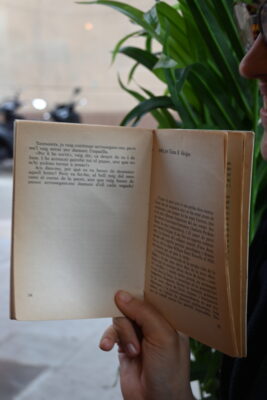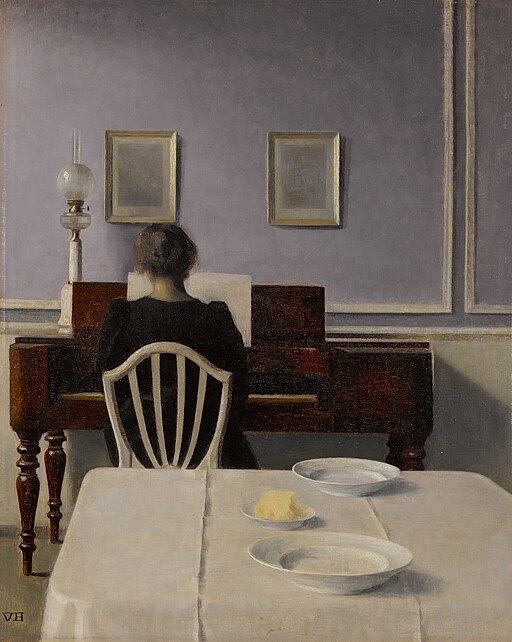A book as brief yet pivotal in gender and feminist studies as The Yellow Wallpaper, comparable to works like Wide Sargasso Sea or A Room of One’s Own, ought to be read early in any literary education—perhaps even during secondary school. Of course, this is hardly a novel claim: for years, it has been a fundamental text in many English university courses. Still, it wasn’t until the book was chosen for the third edition of our book club this year that a copy of Gilman’s story found its way into my hands. At last, I committed to uncovering the truth behind the seemingly supernatural nature of the yellow wallpaper, a subject I had so often heard mentioned in literary circles.

Sarah is the first one to greet me.
This has been one of those occasions when I’ve felt particularly grateful to be part of a book club—grateful that, on that afternoon when we decided to buy second-hand books, have coffee, and chat, someone thought that starting a book club would be a good excuse to meet more often. And it is. But it’s also an exercise in something that, whether due to its seemingly low appeal or the reluctance with which adults often approach reading, I had long resigned myself to considering a solitary, introspective activity. Yet thanks to book clubs, a process akin to surgical precision occurs: the act of reading, understanding, and internalizing a text is prolonged, and the closure—the definitive end when we put the book down—is neutralized. This is because we are compelled to keep reflecting on it (what the book meant, whether we liked it, etc.) in the context of communal engagement. The written discourse produces another discourse—our own—which eventually converges into a collective discourse generated by the different members of the book club. This transforms reading into an active, group activity but, above all, an intellectually stimulating one.
I mention this specific instance because, despite the brevity of The Yellow Wallpaper, it is a text that, intentionally or not, leads to multiple interpretations. In my initial draft, I had written “decipher,” though it’s not quite the right word. It’s not a text that must be “deciphered”; it’s a text whose ultimate truth is challenging to discern and varies depending on the reader. For instance, in my case, even as someone well-versed in literature and the humanities, I found it difficult to pinpoint exactly how the story ends or to declare what the “unequivocal” ending is. And surely, if I had read Gilman without the hope of discussing it with anyone else, I would have categorized the ending as “the depiction of the frenzy of a woman who has gone mad” (with “mad” carrying no negative connotations but rather an objective acknowledgment of her condition).
What did you take away from the ending? Seated at a round table reminiscent of King Arthur’s, coffee in hand, and under the expectant gaze of the other club members, I found myself compelled to formulate a coherent response that I didn’t have. Of course, one knows what the ending means; you feel it, deep down—it’s intuitive; the author hints at it! But then, before I could say anything, I realized that what I had considered universally ambiguous wasn’t so ambiguous after all. Not only that, but I discovered details in the text that I had overlooked or remembered incorrectly. The input of others served to correct and consolidate the impression that Gilman’s story was meant to leave in my literary imagination. It served to instruct me—but through dialogue and collaboration.
We eat cinnamon rolls and cream and pistachio croissants.

The Yellow Wallpaper is essentially about a woman who, after becoming a mother, falls ill. Her doctor and husband decide to take her to a colonial mansion where she must spend the next few months resting in order to recover. However, the circumstances lead her to find herself literally trapped, confined to a room in the house covered with old and decaying yellow wallpaper. It is in this room, and because of this imposed isolation, which she detests, that the narrator—since it is a first-person story—undergoes a transformation that has generally been interpreted as descending into madness.
If this is the framework of the story—with its characters, setting, conflict, etc.—when I finished reading, I hadn’t questioned any of the details provided to the reader. I understood the metaphor being developed in the text, but from the start, I granted absolute validity to the reality that had been presented. Once again, the interesting part emerged when I shared my impressions with the other members of the club. S. and V. didn’t take long, whether consciously or not, to shake the foundations of my understanding: they proposed that the colonial house is actually a psychiatric institution or asylum—or at least that the author uses various details to suggest this, such as the bars on the windows, the structure of the bed where she is isolated, or the very state of the wallpaper. Then I commented that it reminded me of the ending of The Cabinet of Dr. Caligari, which I had seen for the first time only recently. Without dismissing this possibility, L. suggested that the move from one room to another (since the couple initially stayed in a much nicer room on the first floor) is the result of an affair between the maid and John, the husband.
All these impressions may be accurate or not, but the level of accuracy doesn’t take away from how fascinating it is that such different interpretations arise from reading the same text. To some extent, each of these perspectives is valid because they all relate to the theme of the story: the woman’s situation and her living conditions in a society that exploits and oppresses her.

One of the copies of The Yellow Wallpaper.
It is essential to delve into Gilman’s biography because the idea for the story originates from her own experiences, and, going further, its development mirrors the author’s own life situation. Prone to depression and in search of a definitive solution, Gilman consulted a renowned doctor at the time, who prescribed her a “rest cure,” which involved isolation and renouncing all forms of mental effort or activity. Like her protagonist, after three months, Gilman abandoned the treatment to return to work. This episode led her to write The Yellow Wallpaper, with the purpose of illustrating her protest against such an inappropriate form of treatment. Over time, the story has become a denunciation of the mistreatment women often suffer not only at the hands of their husbands and families but also from authority figures such as doctors.
Personally, reading The Yellow Wallpaper reminded me deeply of my earlier reading of Wide Sargasso Sea earlier this year. After all, both stories are, at least superficially, rooted in the tradition of “The Madwoman in the Attic.” However, there is a fundamental difference between the two works—a difference I am not sure I can fully articulate. For one, Wide Sargasso Sea has a more conventional narrative structure: there is character development, shifting perspectives, decisive actions, and, overall, the text feels clearer and more cohesive. The Yellow Wallpaper, on the other hand, is a much more ambiguous text, interweaving many layers of realities and meanings that require careful contemplation to discern. In comparison to Gilman’s story, Jean Rhys’s work possesses a lightness derived from its constant shifts—of characters, places, and situations. Gilman frames The Yellow Wallpaper within an unchanging action, a state of non-being for the narrator, akin to a disease of rust and bloom consuming her from within, all the way to her very soul.
Lidia talking about her impressions on The Yellow Wallpaper.

